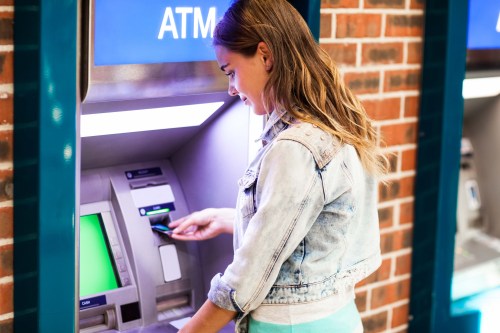What is a Bank and Why Do They Exist?

Teaching kids about money is important, and one way to increase their financial literacy is to explain the ins and outs of banking in Canada. After all, kids love watching coins accumulate in their piggy banks—but what happens to that money if they put it in an actual bank?
Online banking in Canada is so popular that you probably don’t interact much with a physical location, short of grabbing cash at the nearest ATM. So your kids could be forgiven for asking, “What is a bank?” and “Why do banks exist?”
Here’s a closer look at banking in Canada that will help you answer these and other questions your tweens or teens might have.
What is a bank?
Banks are simply companies that provide specific financial-related services. They give people, businesses, and huge institutions a safe place to put their money. You can’t store all those notes under your mattress, can you?
Banks do more than just free up space under our mattresses, though. They also help contribute to the overall function and stability of our economy.
That’s because financial institutions, including banks and credit unions, move money around in our society. When you use a debit card to buy a book, for example, money transfers from your bank account to the bookstore’s bank account. Every day, large sums are transferred between banks to keep the economy running.
Some of the major banks in Canada are still housed in grand, old buildings—step inside one and you’ll get a sense of their long-standing importance. And while today they’re more about apps and e-transfers, these financial institutions are still the backbone of our economy.
Banks can provide a range of other services, too, like investment advice, insurance coverage, and mortgages. There are a number of other types of financial institutions that provide some of the same services as your local bank branch, like credit unions, mortgage companies, investment companies, and insurance companies. But only banks (including online-only banks and credit unions) can take deposits from customers.
Credit unions are very similar to banks. The difference is that they’re non-profit organizations owned by their members (the people who have accounts at that credit union), rather than for-profit companies owned by shareholders (investors who aren’t necessarily customers).
Read more about banking explained for kids.
What is a bank account and how does it work?
Still a bit confused? Let’s break it down further.
First, money can be kept in a savings account at a bank branch, where it earns interest. Think of this as a giant piggy bank—money goes in and then stays there until you need it for something special.
Other bank accounts, like chequing accounts, can be used for managing everyday spending. So if your savings account is like a piggy bank, then your chequing account is like your wallet. You can set it up to make automatic bill payments (no more late phone bill fees!), use a debit card to spend money at the mall, and have your paycheque automatically deposited into your account. Now, that’s sweet.
The major banks in Canada take the money that’s been deposited by customers and let other customers borrow it. This is called a loan and could come in the form of a personal loan, a line of credit, or a mortgage for a home.

What is the purpose of a bank and why does it exist?
You might find yourself wondering, “Why do banks exist?” Well, without them, it would be difficult to exchange goods and services (think of that bubble tea you like, or the next video game you want to download). You also need them to start businesses, save for retirement, or buy a house. That’s why 99 per cent of adults in Canada have an account with a financial institution.
Because banks are for-profit companies, they also exist to make money. For-profit companies are owned by shareholders, who receive a slice of the profits in exchange for their investment. It’s important that banks take this seriously. If they don’t, shareholders might move their money somewhere else.
How did the banking system begin?
Throughout history, various versions of banks and financial institutions have existed to help people exchange goods or store assets for safekeeping. As early as 8,000 BC, people used logs to track trades that were being made. There are also early examples of borrowing from ancient Mesopotamia, with temples and palaces in Babylonia lending out seeds to farmers who would pay back the loan with their harvest.
In the Middle Ages in Europe, merchant banks popped up. Over time, they evolved into banks we know today. Canada’s first bank was founded in 1817. Personal chequing accounts were introduced in 1957, and the first automatic banking machines (ABMs) were introduced by the Royal Bank in 1972. (Back then, they were called Bankettes.) Today, Canadian financial institutions offer a mix of in-person and digital services that help us to make payments, save money, and get loans.
What is the role of banks in Canada?
When you think of banking, the five major banks in Canada probably spring to mind. But there is also another important bank in Canada: the Bank of Canada.
This big-name institution is part of the federal government and has a lot of important jobs. Since 1935, the Bank of Canada has managed monetary policy—that means it tries to keep inflation (the increase in the price of goods) low and stable by increasing or decreasing the interest rate (which affects the amount of interest people pay back on loans). It also oversees the country’s financial system, prints our money, and manages the federal government and crown corporations’ funds.
Commercial banks are the ones you go to when opening a bank account in Canada (like a chequing or savings account) and to apply for loans. There are 88 different banks in Canada, with almost 6,000 branches and close to 19,000 ATMs. That might seem like a lot, but our country’s banking industry is actually on the smaller side. In 2020, there were 4,377 different banks in the United States.
Commercial banks in Canada are regulated by the Canadian government, meaning the government sets the rules. Banks have a few roles: They allow the flow of money between people and companies, and they increase or decrease the money supply at the direction of the Bank of Canada. (There are those parents again, calling the shots!)

How do banks make money?
We know banks’ operate around money. But how do they actually make a profit?
Like most businesses, banks make money by charging their customers for the services they provide. The biggest money-maker is the interest banks collect on the loans they give out. But things like account fees and service fees also go toward the bank’s bottom line.
Financial institutions also make money by offering some services that aren’t directly related to deposits and loans. Think investment management, trust services, and insurance policies.
Learn more about how does interest work.
How do banks contribute to our economy?
Banks are big businesses. Together, they contribute approximately 3.5 per cent to Canada’s gross domestic product (GDP), which is simply the value of all the goods and services produced in the country.
Financial institutions are a major employer in Canada, too. In 2019, more than 280,000 Canadians worked for a bank. Banks paid $30 billion in salaries and benefits in Canada in 2019. Our banks also employ more than 116,000 people in other countries around the world.
What are the pros and cons of banks?
Banks are sort of like coffee shops: You can find them on every corner. That’s because they help the economy run—if they shut down, life would grind to a halt. No more buying pizza, or paying for your cell phone.
Advantages of banks
Here are some of the main benefits of banks:
- A bank is a secure place to keep your money. Without it, you’d be hiding your cash in a shoebox in your closet.
- Banks help people get ahead financially. They can get loans for houses, businesses, and other needs through a bank branch.
- Banking in Canada is super convenient. With so many bank branches across the country, it’s usually fairly easy to visit a teller or find an ATM. Online and mobile banking are also widely accessible.
- Banks have a range of accounts with different services, for a range of fees. This means there are options for everyone.
- Banks, as well as their websites and mobile apps, are generally very secure.
Disadvantages of banks
There are some downsides to banks, too:
- Banks readily give out loans, which is generally a good thing for our economy. That said, on an individual level, you don’t want to get too deep into debt—and having easy access to credit can make it tempting to spend more than you earn.
- It’s easy to get small amounts of cash from a bank branch or ATM, but large amounts can be trickier to access. If you need a lot of money—say, for a deposit on a house or to buy a used car—it may take some time to get it.
The future of banking in Canada
Canadian financial institutions have come a long way since the first bank opened in 1817. And, good news: They continue to evolve.
Spurred by the COVID-19 pandemic, banks have gone increasingly digital. That means your ability to make payments and deposits via mobile devices has increased and will continue to do so. Soon, your phone might be all you need for personal money management. Convenient, right?
It’s clear that banks are important, and they’re not going away anytime soon. If anything, they’re becoming more accessible in this digital world—and young people want in on the action. Teaching kids about money is important, so download Mydoh and help build a solid foundation of financial literacy for your kids and teenagers.
This article offers general information only and is not intended as legal, financial or other professional advice. A professional advisor should be consulted regarding your specific situation. While the information presented is believed to be factual and current, its accuracy is not guaranteed and it should not be regarded as a complete analysis of the subjects discussed. All expressions of opinion reflect the judgment of the author(s) as of the date of publication and are subject to change. No endorsement of any third parties or their advice, opinions, information, products or services is expressly given or implied by Royal Bank of Canada or its affiliates.














